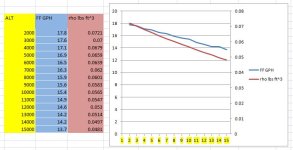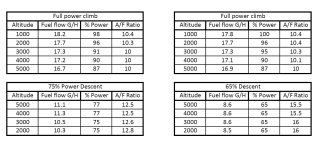PilotjohnS
Well Known Member
just me
I have the Bendix RSA clone on my stock Lycoming. It claims to keep a constant F?A mixture during climb but I find I need to tweak it as altitude or Baro setting changes. I typically run peak EGT cruise (65% power). And when I reduce power for descent, I need to richen and reset peak EGT once descent rate and power are reset. YMMV
I don't have any answers to these questions as they seem to be oriented to an assumed EFI environment. I have a normally aspirated mechanical Precision Automotive/RSA type fuel injection system on the I/O-390, and once an A/F ratio is set, the servo controls the fuel flow in step with the airflow as the plane climbs, keeping the A/F constant. That said, I will do a flight soon and verify the details of that - mainly I know I never seem to re-adjust mixture because the A/F changed. Of course, in a carbureted environment, it's a different story.
Using A/F in conjunction with one of the available experimental EFI systems - I don't know what they already do and what one might adjunct and the risks involved. But with mechanical fuel injection, the use of wideband A/F measurement and user's mixture control is low risk, apart from keeping track that the O2 sensor is still happy in the lowlead environment.
I have the Bendix RSA clone on my stock Lycoming. It claims to keep a constant F?A mixture during climb but I find I need to tweak it as altitude or Baro setting changes. I typically run peak EGT cruise (65% power). And when I reduce power for descent, I need to richen and reset peak EGT once descent rate and power are reset. YMMV






